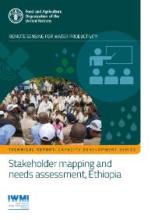/ library resources
Showing items 1 through 9 of 33.Widespread heat waves, floods, and droughts last year were a strong reminder of the threats posed by climate change. In the non-tropical dry areas where ICARDA works we are becoming accustomed to record high temperatures and increasing water scarcity year on year.
ICARDA has long-standing outreach programs in North Africa, the Nile Valley, and the Red Sea region (Fig 2). In its current strategic plan, the Center will extend its work to the drylands of Sub-Saharan Africa.
Ethiopia is one of the most populated and poorest countries in Sub-Saharan Africa and as such has been a high priority country for IFPRI research and capacity-building work.
Achieving gender equality in irrigation can result in greater production, income, and job opportunities for both men and women smallholder farmers from diverse social groups, while building climate resilience in sub-Saharan Africa.
Ethiopia has the largest livestock population in Africa. According to a CSA (2021) livestock sample survey, the country possesses 70.3 million cattle, 42.9 million sheep, 52.5 million goats and 8.1 million camels.
Fact sheet on capacity development actvities of Action Against Desertification.
This brochure presents recent digital innovations that enable a more effective, efficient and transparentin land management. It refers to examples in Peru, Ethiopia and Laos.
Given the scarcity of land and water resources, global strategies to increase food production should focus efforts on increasing production per unit resources, i.e.
Pagination
Land Library Search
Through our robust search engine, you can search for any item of the over 73,000 highly curated resources in the Land Library.
If you would like to find an overview of what is possible, feel free to peruse the Search Guide.






